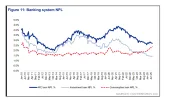
Singapore banks' bad loans are on the rise
Aggregate NPL ratio of local banking groups rose from 0.4% to 1.6% in 2017.
Bad loans are slowly rising over the past 12 months in Singapore following a decade of historically low figures, according to a report from accounting firm Deloitte.
The aggregate non-performing loan ratio of local banking groups rose from 0.4% in 2016 to 1.6% in 2017. In a breakdown, the NPLs of the country’s largest banks—DBS, UOB and OCBC—fall within a range of 1.3% to 1.7% as of Q3 2017.
“Exposures to regional economies and the oil and gas industries, which are experiencing slowdowns, have contributed to this rise in NPLs,” Deloitte noted. “This trend is to be expected given the low rate of NPLs prior to economic conditions weakening.”
Also read: On-time payments by construction firms are boosting Singapore banks
The three major banking players also have larger NPL exposures to regional economies as UOB and OCBC have 4.9% and 3.7% in Indonesia respectively whilst DBS reports 4.1% exposure in South and Southeast Asia.
Despite the slight uptick, bad loans lie within a low and manageable range and the banking sector in Singapore remains healthy with strong capital and liquidity buffers in place to weather market shocks, according to Deloitte.



















 Advertise
Advertise






